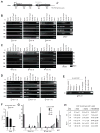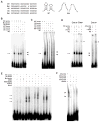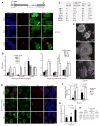Polycomb proteins targeted by a short repeat RNA to the mouse X chromosome
- PMID: 18974356
- PMCID: PMC2748911
- DOI: 10.1126/science.1163045
Polycomb proteins targeted by a short repeat RNA to the mouse X chromosome
Abstract
To equalize X-chromosome dosages between the sexes, the female mammal inactivates one of her two X chromosomes. X-chromosome inactivation (XCI) is initiated by expression of Xist, a 17-kb noncoding RNA (ncRNA) that accumulates on the X in cis. Because interacting factors have not been isolated, the mechanism by which Xist induces silencing remains unknown. We discovered a 1.6-kilobase ncRNA (RepA) within Xist and identified the Polycomb complex, PRC2, as its direct target. PRC2 is initially recruited to the X by RepA RNA, with Ezh2 serving as the RNA binding subunit. The antisense Tsix RNA inhibits this interaction. RepA depletion abolishes full-length Xist induction and trimethylation on lysine 27 of histone H3 of the X. Likewise, PRC2 deficiency compromises Xist up-regulation. Therefore, RepA, together with PRC2, is required for the initiation and spread of XCI. We conclude that a ncRNA cofactor recruits Polycomb complexes to their target locus.
Figures





Similar articles
-
Synergy of Eed and Tsix in the repression of Xist gene and X-chromosome inactivation.EMBO J. 2008 Jul 9;27(13):1816-26. doi: 10.1038/emboj.2008.110. Epub 2008 May 29. EMBO J. 2008. PMID: 18511907 Free PMC article.
-
The long noncoding RNA, Jpx, is a molecular switch for X chromosome inactivation.Cell. 2010 Oct 29;143(3):390-403. doi: 10.1016/j.cell.2010.09.049. Cell. 2010. PMID: 21029862 Free PMC article.
-
Recruitment of PRC1 function at the initiation of X inactivation independent of PRC2 and silencing.EMBO J. 2006 Jul 12;25(13):3110-22. doi: 10.1038/sj.emboj.7601187. Epub 2006 Jun 8. EMBO J. 2006. PMID: 16763550 Free PMC article.
-
Xist gene regulation at the onset of X inactivation.Curr Opin Genet Dev. 2009 Apr;19(2):122-6. doi: 10.1016/j.gde.2009.03.003. Epub 2009 Apr 1. Curr Opin Genet Dev. 2009. PMID: 19345091 Review.
-
Noncoding RNA and Polycomb recruitment.RNA. 2013 Apr;19(4):429-42. doi: 10.1261/rna.037598.112. Epub 2013 Feb 19. RNA. 2013. PMID: 23431328 Free PMC article. Review.
Cited by
-
Chromatin-bound RNA and the neurobiology of psychiatric disease.Neuroscience. 2014 Apr 4;264:131-41. doi: 10.1016/j.neuroscience.2013.06.051. Epub 2013 Jul 3. Neuroscience. 2014. PMID: 23831425 Free PMC article. Review.
-
ANRIL: molecular mechanisms and implications in human health.Int J Mol Sci. 2013 Jan 10;14(1):1278-92. doi: 10.3390/ijms14011278. Int J Mol Sci. 2013. PMID: 23306151 Free PMC article. Review.
-
X-inactivation: quantitative predictions of protein interactions in the Xist network.Nucleic Acids Res. 2013 Jan 7;41(1):e31. doi: 10.1093/nar/gks968. Epub 2012 Oct 22. Nucleic Acids Res. 2013. PMID: 23093590 Free PMC article.
-
Balancing cohesin eviction and retention prevents aberrant chromosomal interactions, Polycomb-mediated repression, and X-inactivation.Mol Cell. 2021 May 6;81(9):1970-1987.e9. doi: 10.1016/j.molcel.2021.02.031. Epub 2021 Mar 15. Mol Cell. 2021. PMID: 33725485 Free PMC article.
-
Environmental Health and Long Non-coding RNAs.Curr Environ Health Rep. 2016 Sep;3(3):178-87. doi: 10.1007/s40572-016-0092-1. Curr Environ Health Rep. 2016. PMID: 27234044 Free PMC article. Review.
References
Publication types
MeSH terms
Substances
Associated data
- Actions
Grants and funding
LinkOut - more resources
Full Text Sources
Other Literature Sources
Molecular Biology Databases

